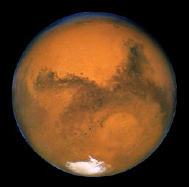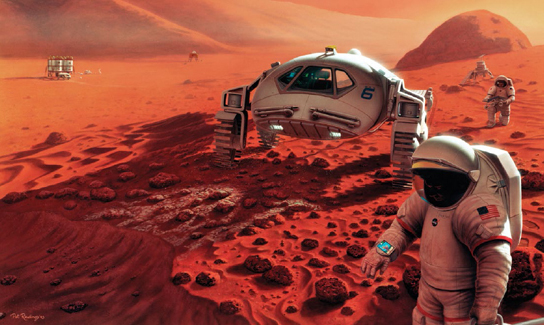~2035–2050
First Humans on Mars?
Decades of high-resolution observations from telescopes and robotic flybys, orbiters, landers, and rovers have continually increased the allure of Mars exploration. Evidence from the geology, mineralogy, and atmosphere of Mars points to a dramatic change in the planet’s climate during its history. Today the Martian surface is cold, dry, and, as far as we can tell, inhospitable, but early Mars, for the first billion years after its formation, was a warmer and wetter planet. While it was probably never as warm and wet as our own planet, evidence suggests that it was more Earthlike and habitable.
But was or is Mars inhabited? Robotic missions have mapped the planet and documented the conditions at a variety of landing sites, but a serious search for past or present evidence of life on Mars will be much harder. Like a forensic investigation, it will require piecing together clues from scattered fragments of evidence in order to see the big picture. The job will be comparable to what field geologists do here on the Earth, reconstructing the history of a region only after years of methodical field and laboratory work, combined with experience at other sites and, often, gut feelings and instincts. It will require more detailed geologic mapping, plus probable coring and deep drilling. In short, people, not just robots, will be needed to truly understand the place.
When will humans go to Mars? No one knows, but the imperative is growing, fueled by the discoveries of our robotic precursor emissaries. The mid-2030s is a guess, driven partly by NASA’s advances in deep space rocketry as well as the goals of private companies such as SpaceX that are devising their own plans for sending people to Mars.
More than 50 years ago president John F. Kennedy challenged Americans to dream big and take a bold risk by attempting to send astronauts to the Moon and back before 1970. The Apollo missions inspired a generation of scientific and technological innovation that has truly changed the world. Sending astronauts to Mars and back will be much riskier and much bolder. Can we once again rise to the challenge?

Hubble Space Telescope photo of Mars on August 26, 2003, at its closest approach to Earth in 60,000 years.
SEE ALSO Mars (c. 4.5 Billion BCE), Mars and Its Canals (1906), First on the Moon (1969), Second on the Moon (1969), Fra Mauro Formation (1971), Roving on the Moon (1971), Lunar Highlands (1972), Last on the Moon (1972), First Mars Orbiters (1971), Vikings on Mars (1976), Life on Mars? (1996), First Rover on Mars (1997), Mars Global Surveyor (1997), Spirit and Opportunity on Mars (2004).
NASA artist Pat Rawlings’s conception of two astronaut explorers on Mars and their wheeled Mars roving vehicle, collecting samples and scouting for signs of past habitable environments.
